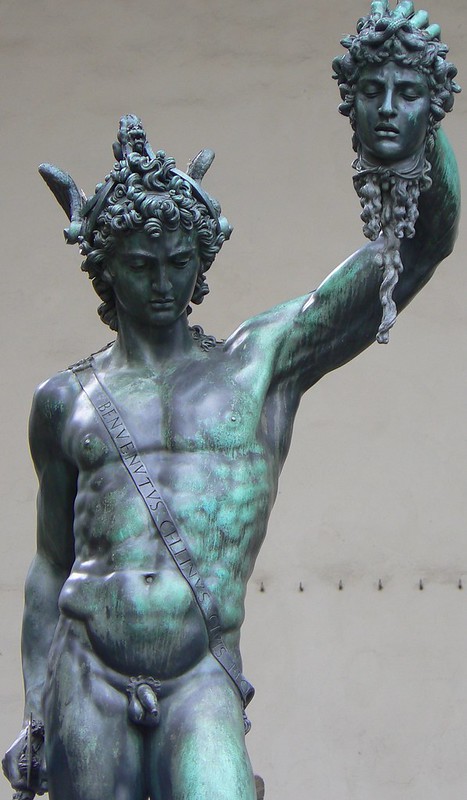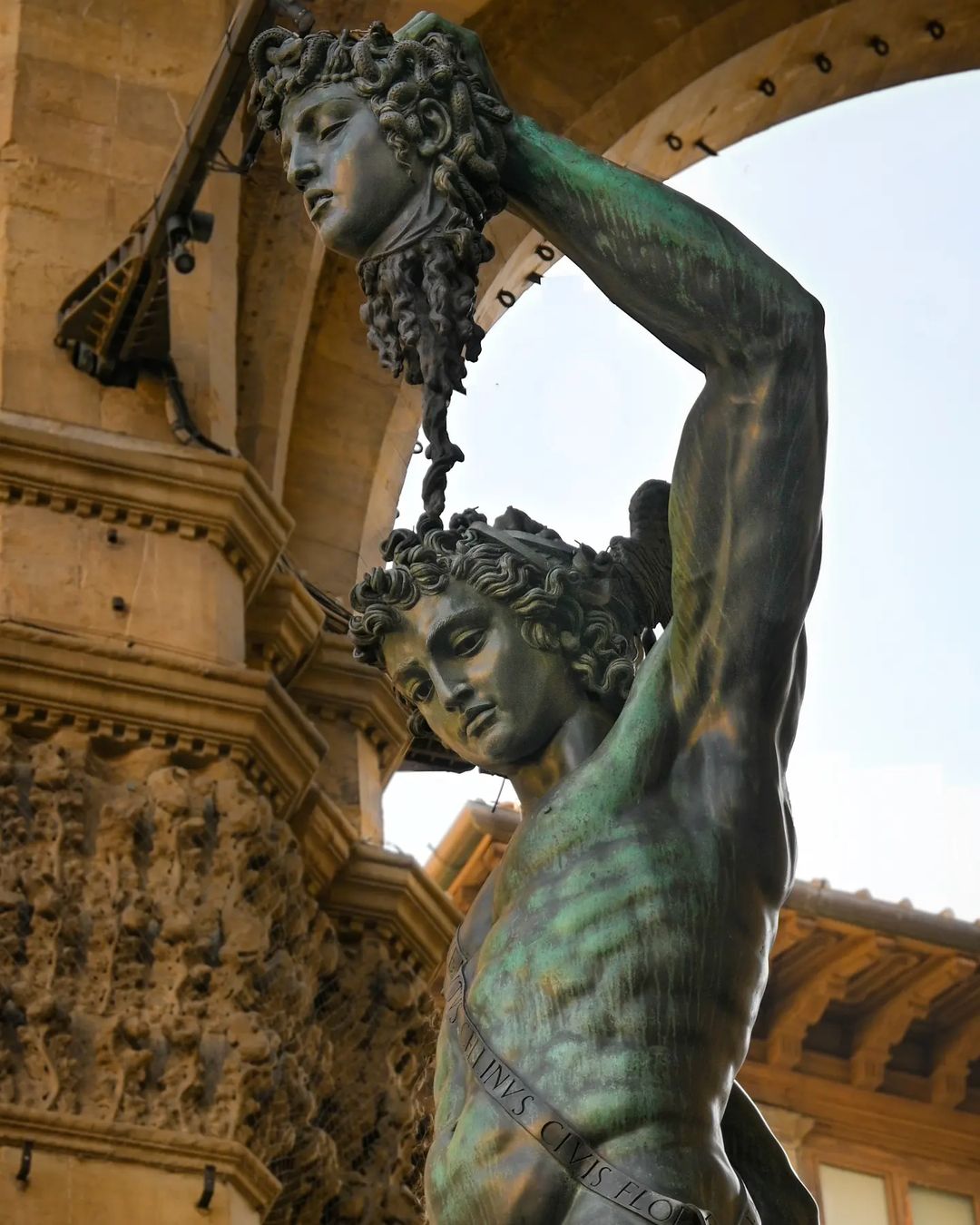Introduction: A Renaissance Masterpiece Overlooked
In the heart of Florence’s iconic Piazza della Signoria, a towering bronze sculpture commands attention, yet often finds itself in the shadow of Michelangelo’s renowned David. This magnificent work of art is Benvenuto Cellini’s Perseus with the Head of Medusa, a 16th-century masterpiece that tells a captivating story of heroism, mythology, and the artistic genius of the Italian Renaissance.

While Michelangelo’s David may be the more famous and celebrated sculpture in the piazza, Cellini’s Perseus deserves equal, if not greater, recognition as a testament to the skill, creativity, and technical mastery of one of the most renowned Renaissance artists. This blog post will delve into the rich history, symbolism, and artistic significance of this remarkable bronze titan, shedding light on why Cellini’s Perseus deserves to stand proudly alongside the most iconic works of the Italian Renaissance.
The Artist: Benvenuto Cellini, Renaissance Polymath
Benvenuto Cellini was a true Renaissance man, known for his versatility and expertise in a wide range of artistic disciplines. Born in Florence in 1500, Cellini was a goldsmith, sculptor, painter, musician, and author, whose talents and accomplishments spanned the artistic spectrum of the Italian Renaissance.

Cellini’s early life was marked by a tumultuous and often violent nature, with accounts of duels, brawls, and even a brief stint in prison. However, it was this very passion and intensity that would later be channeled into his artistic creations, imbuing them with a sense of dynamism and raw emotion.
As a young man, Cellini honed his skills as a goldsmith, creating intricate and highly sought-after works for the Medici family and other prominent patrons. His reputation as a master craftsman soon spread, and he was commissioned to create some of the most significant works of the Renaissance, including the famous salt cellar for Francis I of France.
The Commission: Cellini’s Ambitious Undertaking
In the 1540s, Cellini was given the prestigious commission to create a bronze statue for the Piazza della Signoria, the political and cultural heart of Florence. The subject of the sculpture was to be Perseus, the mythological Greek hero who slew the gorgon Medusa, and the work was to be a celebration of the Medici family’s triumph over their political rivals.

Cellini approached this commission with characteristic passion and determination, seeing it as an opportunity to showcase his artistic virtuosity and cement his legacy as one of the greatest sculptors of the Renaissance. He spent years meticulously planning and executing the project, facing numerous technical and logistical challenges along the way.
The sheer scale of the sculpture was a testament to Cellini’s ambition – the bronze figure of Perseus stands over 5 meters tall, with the severed head of Medusa clutched in his outstretched hand. The level of detail and anatomical accuracy in the sculpture is truly remarkable, with every muscle and sinew meticulously rendered in bronze.
The Symbolism: Heroism, Power, and the Medici Legacy
Cellini’s Perseus with the Head of Medusa is more than just a technical masterpiece; it is also a work rich in symbolic meaning and political significance. The choice of Perseus as the subject was no accident, as the mythological hero’s triumph over the gorgon Medusa was seen as a metaphor for the Medici family’s victory over their political rivals.

The severed head of Medusa, with its snakes writhing and its petrifying gaze, represents the power of the Medici family to overcome their enemies and assert their dominance. The figure of Perseus, standing tall and triumphant, embodies the qualities of heroism, courage, and strength that the Medici family sought to project.
Furthermore, the placement of the sculpture in the Piazza della Signoria was a strategic decision, as this was the political and civic heart of Florence. By positioning the Perseus statue in this prominent location, the Medici family was asserting their control over the city and their role as the rightful rulers of the Florentine Republic.
The Artistic Mastery: Cellini’s Technical Virtuosity
Cellini’s Perseus with the Head of Medusa is not only a work of immense symbolic significance but also a testament to the artist’s unparalleled technical mastery. The sheer scale and complexity of the sculpture are breathtaking, with Cellini demonstrating his virtuosity in every aspect of the work.
The bronze casting process, which Cellini oversaw himself, was an incredibly challenging and risky undertaking. The massive size of the sculpture, combined with the intricate details and delicate features, made the casting process extremely difficult, with Cellini facing numerous setbacks and technical obstacles along the way.

Despite these challenges, Cellini’s perseverance and artistic vision shone through, resulting in a sculpture that is a true marvel of Renaissance engineering and craftsmanship. The level of detail and anatomical accuracy in the sculpture is truly remarkable, with every muscle, vein, and sinew meticulously rendered in bronze.
Cellini’s mastery is also evident in the dynamic, almost cinematic, pose of the Perseus figure. The hero is depicted in a moment of action, his body twisting and his limbs tensed, as he prepares to strike down the gorgon Medusa. This sense of movement and energy is a hallmark of Cellini’s artistic style, and it helps to imbue the sculpture with a palpable sense of power and vitality.
The Controversy and Legacy: Cellini’s Tumultuous Journey
The creation of Perseus with the Head of Medusa was not without its share of controversy and drama. Cellini’s famously volatile temperament and his clashes with patrons and rivals are well-documented, and the Perseus commission was no exception.
Throughout the years-long process of designing and executing the sculpture, Cellini faced numerous setbacks and challenges, including financial difficulties, political intrigue, and even a near-fatal illness. At one point, the artist even resorted to hiding in his workshop to avoid his creditors, determined to complete the commission at all costs.

Despite these obstacles, Cellini persevered, driven by his unwavering artistic vision and his desire to create a masterpiece that would cement his legacy as one of the greatest sculptors of the Renaissance. The final result, the towering bronze figure of Perseus, was a triumph not only for Cellini but also for the Medici family, who had commissioned the work.
Today, Cellini’s Perseus with the Head of Medusa stands as a testament to the artist’s technical virtuosity, his creative genius, and his enduring legacy. The sculpture has become an iconic symbol of the Italian Renaissance, a masterpiece that continues to captivate and inspire art enthusiasts and scholars alike.
Conclusion: A Titan Among Titans
In the bustling Piazza della Signoria, where Michelangelo’s David commands the attention of millions of visitors, Benvenuto Cellini’s Perseus with the Head of Medusa stands as a testament to the enduring power and brilliance of the Italian Renaissance. This magnificent bronze sculpture, with its dynamic pose, exquisite detail, and rich symbolic meaning, deserves to be recognized as one of the greatest works of art from this pivotal era in Western history.
Through Cellini’s Perseus, we catch a glimpse into the artistic virtuosity, the technical mastery, and the passionate vision that defined the Italian Renaissance. This sculpture is not just a masterpiece of bronze casting and sculptural technique; it is a work that encapsulates the very essence of the Renaissance spirit – a spirit of ambition, innovation, and a relentless pursuit of artistic perfection.
As you wander through the Piazza della Signoria and gaze upon the towering figure of Perseus, take a moment to appreciate the enduring legacy of Benvenuto Cellini and the indelible mark he has left on the world of art. For in this bronze titan, we see the embodiment of the Renaissance’s greatest achievements, a testament to the power of the human spirit to create works of unparalleled beauty and timeless significance.

